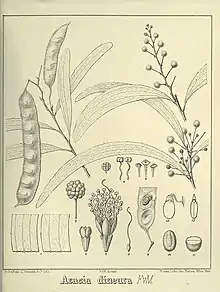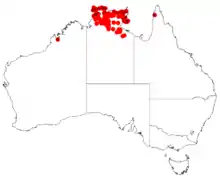| Acacia latescens | |
|---|---|
 | |
| A. latescens (as A. dineura) | |
| Scientific classification | |
| Kingdom: | Plantae |
| Clade: | Tracheophytes |
| Clade: | Angiosperms |
| Clade: | Eudicots |
| Clade: | Rosids |
| Order: | Fabales |
| Family: | Fabaceae |
| Subfamily: | Caesalpinioideae |
| Clade: | Mimosoid clade |
| Genus: | Acacia |
| Species: | A. latescens |
| Binomial name | |
| Acacia latescens | |
 | |
| Occurrence data from AVH | |
| Synonyms[4] | |
|
Acacia dissoneura F.Muell. | |
Acacia latescens, also known as Ball wattle,[5] is a tree in the genus Acacia (in the family Fabaceae and the subgenus Plurinerves).[6][7] It is native to the Northern Territory where it is common in the Top End.[1]
Description
A. latescens is a tree growing from 4 to 9 m high. Its bark is brown and fissured. The smooth branchlets are ribbed, and its stipules fall. The pulvinus is 3-5 mm long and smooth. The smooth phyllodes are curved, and are 80-260 mm long by 4-18 mm wide. They have two primary veins (sometimes 1 or 3) and the secondary may be oblique, veined like a feather or forming a network. The base of the phyllode narrows gradually but the apex is acute. There are three glands along the dorsal margin and at the pulvinus. The axilliary inflorescences are racemes or panicles, with 4-11 heads per raceme. The white/cream heads are globular, and 4-6 mm wide on smooth peduncles which are 5-16 mm long. The greyish pods (50-210 mm long by 11-20 mm wide) are straight, and raised over the seeds with a slightly thickened margin. The dark brown to black seeds (9-10 mm long by 5-7 mm wide) are oblique in the pod.[1]
It flowers from April to July and fruits from August to January.[1]
Distribution
It is found in the following bioregions of the Northern Territory: Arnhem Coast, Arnhem Plateau, Central Arnhem, Daly Basin, Darwin Coastal, Gulf Fall and Uplands, Pine Creek, Sturt Plateau, Tiwi Cobourg, and Victoria Bonaparte.[1]
Habitat
It grows in eucalypt woodland.[1]
Taxonomy
It was first described by George Bentham in 1842, from a specimen collected by Allan Cunningham on May-Day Island in van Diemen's Gulf,[2][3] in 1818 on the first voyage of the Mermaid (Isolectotype BM000796904).[8]
References
- 1 2 3 4 5 6 "NT Flora factsheet: Acacia latescens". eflora.nt.gov.au. Retrieved 14 December 2019.
- 1 2 "Acacia latescens". Australian Plant Name Index, IBIS database. Centre for Plant Biodiversity Research, Australian Government.
- 1 2 Bentham, G. (1842). "Notes on Mimoseae, with a synopsis of species". In Hooker, W.J. (ed.). London Journal of Botany. Vol. 1. H. Baillière. p. 380.
- ↑ "Acacia latescens Benth". Plants of the World Online. Retrieved 13 December 2019.
- ↑ Cowan, R.S. (2019). "Acacia latescens Benth". Flora of Australia. Australian Biological Resources Study, Department of the Environment and Energy, Canberra. Archived from the original on 15 April 2021. Retrieved 14 December 2019.
- ↑ Stirton, C.; Maslin, B. (1998). "Generic and infrageneric classification in Acacia". Bulletin of the Mimosoidae Working Group. 20.
- ↑ "Species Introduction: Acacia latescens". worldwidewattle.com. Archived from the original on 22 July 2005. Retrieved 13 December 2019.
- ↑ "Isolectotype of Acacia latescens Benth. [family LEGUMINOSAE] on JSTOR". plants.jstor.org.
